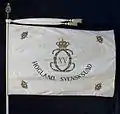Blekinge Battalion
Blekinge Battalion (Swedish: Blekinge bataljon), designated № 30, was an infantry unit of the Swedish Army that was active in various forms from 1887 to 1901. The unit was based in Ronneby.[2][3][4]
| Blekinge Battalion | |
|---|---|
| Blekinge bataljon | |
| Active | 1887–1901 |
| Country | Sweden |
| Allegiance | Swedish Armed Forces |
| Branch | Swedish Army |
| Type | Infantry |
| Size | Battalion |
| Part of | 2nd Military District (1887–1893) 2nd Army Division (1893–1901) |
| Garrison/HQ | Ronneby |
| March | "Donaugruss" (Král)[note 1] |
| Battle honours | Hogland (1788), Svensksund (1789) |
| Insignia | |
| Colour m/1867 |  |
History
Blekinge Battalion was raised on 1 January 1887, to serve the conscripts of Blekinge County. Its officers were mainly taken from the disbanded Marine Regiment, and the force's strength was set at 300 men, which, in favor of Halland Battalion, was somewhat reduced according to the 1892 parliamentary decision.[5] The battalion was based in Ronneby and trained at Bredåkra,[5] at present Ronneby Airport.
According to the 1901 Defense Reform, the battalion was disbanded as an independent unit on 31 December 1901. Instead it came together with Småland Grenadier Corps (№ 7) to form Karlskrona Grenadier Regiment on 1 January 1902.[3]
Barracks and training areas
When the battalion was raised in 1887 it was transferred to Vämö plain and had its staff in Karlskrona. In 1888, the battalion came to be relocated to Bredåkra, and on 1 October 1891 the staff was placed to Ronneby. On 1 May 1890, the battalion's volunteer school was transferred to Bredåkra. After the battalion was disbanded, the battalion's camp at Bredåkra was brought into use by the Swedish Air Force, when Blekinge Wing (F 17) was formed in 1944 and was transferred to Bredåkra. Blekinge Battalion in Ronneby came to house Ågården's nursing home for mentally ill. In 1968 the building was demolished.[3]
Commanding officers
- 1889–1899: Major James Douglas Haasum
- 1900–1902: Major Curt Johan Elof Rosenblad
Names, designations and locations
| Name | Translation | From | To | |
|---|---|---|---|---|
| Kungl. Blekinge bataljon | Royal Blekinge Battalion | 1887-01-01 | – | 1901-12-31 |
| Designation | From | To | ||
| № 30 | 1887-01-01 | – | 1901-12-31 | |
| Location | From | To | ||
| Vämö | 1887-??-?? | – | 1888-??-?? | |
| Ronneby | 1891-10-01 | – | 1901-12-31 | |
| Bredåkra | 1888-??-?? | – | 1901-12-31 |
Footnotes
- The march was adopted in the late 1800s and was shared with the Värmland Rifle Corps (Värmlands fältjägarkår, I 26). The march is used by the Swedish Armed Forces Centre for Defence Medicine since 1998.[1]
References
Notes
- Sandberg 2007, p. 44
- Braunstein 2003, pp. 45–46
- Holmberg 1993, p. 17
- Kjellander 2003, p. 276
- Westrin 1896, p. 923
Print
- Braunstein, Christian (2003). Sveriges arméförband under 1900-talet. Skrift / Statens försvarshistoriska museer, 1101-7023 ; 5 (in Swedish). Stockholm: Statens försvarshistoriska museer. ISBN 91-971584-4-5. SELIBR 8902928.
- Holmberg, Björn (1993). Arméns regementen, skolor och staber: [en uppslagsbok] : en sammanställning (in Swedish). Arvidsjaur: Svenskt militärhistoriskt bibliotek (SMB). ISBN 91-972209-0-6. SELIBR 7796532.
- Kjellander, Rune (2003). Sveriges regementschefer 1700-2000: chefsbiografier och förbandsöversikter (in Swedish). Stockholm: Probus. ISBN 91-87184-74-5. SELIBR 8981272.
- Sandberg, Bo (2007). Försvarets marscher och signaler förr och nu: marscher antagna av svenska militära förband, skolor och staber samt igenkännings-, tjänstgörings- och exercissignaler (in Swedish) (New ed.). Stockholm: Militärmusiksamfundet med Svenskt marscharkiv. ISBN 978-91-631-8699-8. SELIBR 10413065.
- Westrin, Theodor, ed. (1896). Nordisk familjebok: konversationslexikon och realencyklopedi innehållande upplysningar och förklaringar om märkvärdiga namn, föremål och begrepp (in Swedish). Vol. 19. Stockholm. SELIBR 78095.
{{cite book}}: CS1 maint: location missing publisher (link)